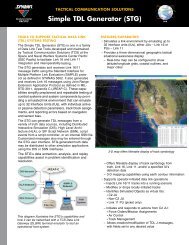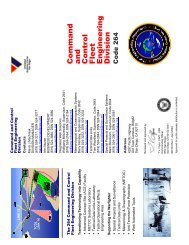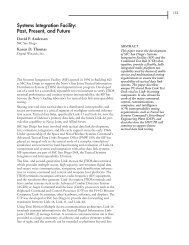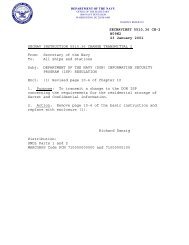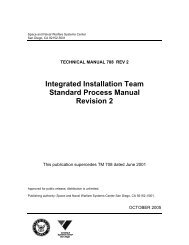Intelligence, Surveillance, and Reconnaissance - Spawar
Intelligence, Surveillance, and Reconnaissance - Spawar
Intelligence, Surveillance, and Reconnaissance - Spawar
You also want an ePaper? Increase the reach of your titles
YUMPU automatically turns print PDFs into web optimized ePapers that Google loves.
The eXtensible Tactical C4I Framework (XTCF)<br />
LCDR Mark V. Glover, USN<br />
SSC San Diego<br />
BACKGROUND<br />
The Department of Defense has embarked on a major effort to transform<br />
the management of information to enhance operational decision-making,<br />
improve combat operations, <strong>and</strong> realize intelligence advantages. This<br />
new, net-centric approach will incorporate network <strong>and</strong> communications<br />
enhancements to support operational users at all levels. A key aspect is<br />
making reliable data equally available to users at all levels, from headquarters<br />
to the "edge" of the network.<br />
The current approach to comm<strong>and</strong> <strong>and</strong> control of operational forces is<br />
based on using the Common Operating Environment (COE) to provide<br />
a set of common services <strong>and</strong> adding mission-specific applications. The<br />
Global Comm<strong>and</strong> <strong>and</strong> Control System (GCCS), which is the present<br />
Joint comm<strong>and</strong> <strong>and</strong> control (C2) system, allows Operational<br />
Comm<strong>and</strong>ers to maintain dominant battlefield awareness through a<br />
fused, near-real-time picture of the battlespace. GCCS provides<br />
Operational Comm<strong>and</strong>ers with integrated imagery <strong>and</strong> intelligence,<br />
situational awareness, indications <strong>and</strong> warnings, collaborative planning,<br />
course-of-action development, <strong>and</strong> intelligence mission support. GCCS<br />
consists of hardware, software, procedures, st<strong>and</strong>ards, <strong>and</strong> interfaces for<br />
connectivity worldwide at all levels of comm<strong>and</strong>, <strong>and</strong> it supports <strong>and</strong><br />
integrates a wide assortment of mission-critical, joint, service, <strong>and</strong> siteunique<br />
applications, databases, <strong>and</strong> office-automation tools.<br />
A key capability in GCCS is the Tactical Management System (TMS).<br />
TMS is the tactical database management <strong>and</strong> correlation engine for<br />
COE-based systems including GCCS, the Maritime variant (GCCS–M),<br />
the Army variant (GCCS–A) <strong>and</strong> <strong>Intelligence</strong> Analysis System (IAS),<br />
<strong>and</strong> the Air Force Theater Battle Management Core Systems (TBMCS).<br />
TMS facilitates the ability of comm<strong>and</strong> <strong>and</strong> control systems to receive,<br />
display, correlate, fuse, <strong>and</strong> maintain locational information on friendly,<br />
hostile, <strong>and</strong> neutral l<strong>and</strong>, sea, <strong>and</strong> air forces <strong>and</strong> integrate it with available<br />
intelligence <strong>and</strong> environmental information.<br />
The current TMS implementation is based on a client–server architecture<br />
that provides data replication <strong>and</strong> synchronization services across a<br />
multi-layered network distribution topology. The TMS database consists<br />
of a large number of pre-defined track types, each with rules for correlation,<br />
association, <strong>and</strong> data field promotion. TMS also serves as a tactical<br />
event notifier that allows mission applications to register for <strong>and</strong> receive<br />
track update, change, merge, <strong>and</strong> delete events in order to provide operational<br />
users with a current tactical track picture.<br />
ABSTRACT<br />
This paper describes a development<br />
project for the Office<br />
of Naval Research (ONR) to<br />
provide a new framework for<br />
integrating current <strong>and</strong> emerging<br />
tactical data sources seamlessly.<br />
The eXtensible Tactical<br />
Comm<strong>and</strong>, Control, Communications,<br />
Computers, <strong>and</strong><br />
<strong>Intelligence</strong> (C4I) Framework<br />
(XTCF) will transform software<br />
development in the next<br />
generation of comm<strong>and</strong> <strong>and</strong><br />
control tactical data management<br />
services. XTCF will provide<br />
a common information<br />
management framework that<br />
will enable multiple data<br />
sources, transformation<br />
services, analysis tools, <strong>and</strong><br />
data management services<br />
to cooperate in producing a<br />
common tactical information<br />
network service.<br />
151



